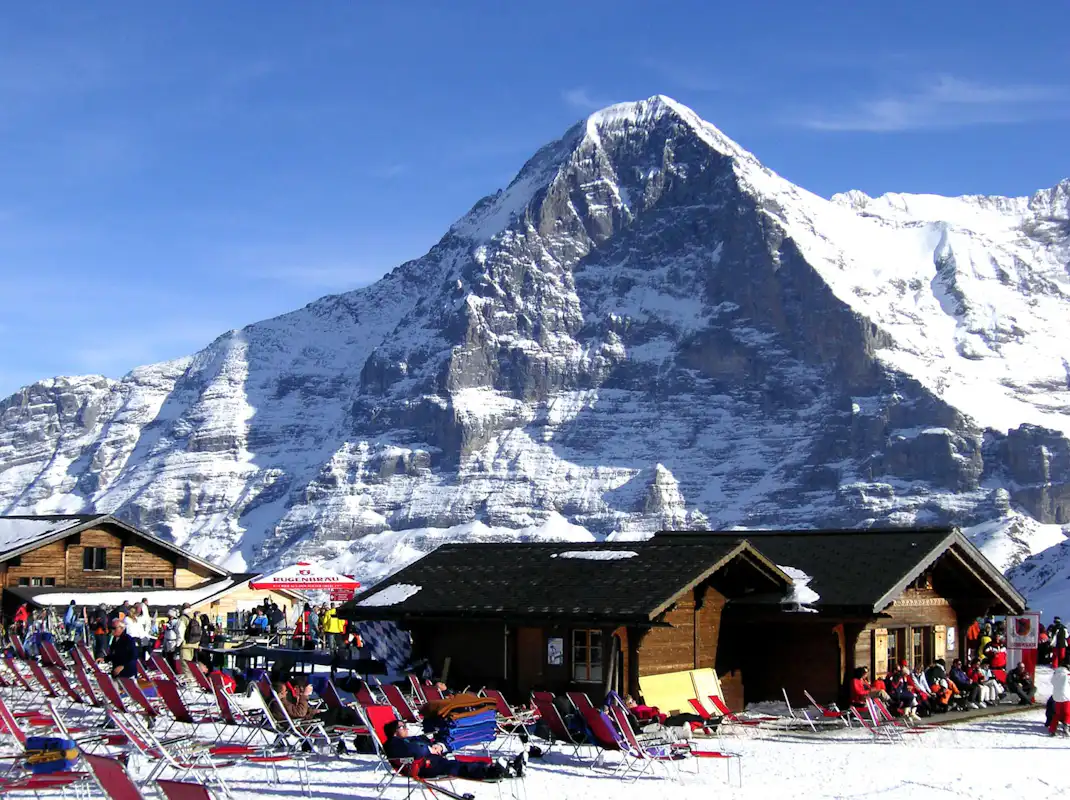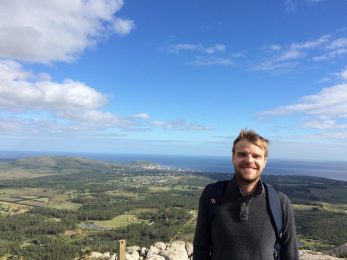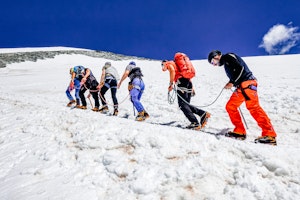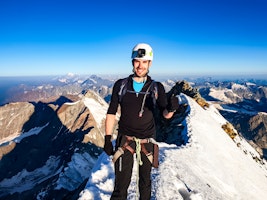Towering 3.967 meters above sea level, Eiger is part of a famous trio of mountains that includes the Jungfrau and Mönch in south-central Switzerland.
The peak is one of the most famous mountaineering destinations in the Bernese Oberland as well as the Alps, at large. It has long been popular with climbers, offering multiple routes up to the summit, one of which is the infamous North Wall.
Known as the Nordwand (north wall) in German, it has earned the nickname Mordwand, a pun on Nordwand that means death wall, for the numerous climbers – 64 in total – who have died attempting to climb it.
However, many of these deaths occurred during summer ascents, which has led to most climbers avoiding this route during the summer. Climbing the easier Mittellegi Ridge is best done during this season.
Autumn and springtime are ideal for the famous North Wall, which is considered one of the best classic and challenging north face climbs in the Alps!
Either way, regardless of when you climb Eiger, you are in for a treat. Stunning views of the mountains and valleys of the Bernese Oberland, as well as the massive glaciers, await you at the summit.
If you are hardy enough to climb the peak during the winter, views of the wondrous Swiss wintertime landscape, which stretches out beneath you, are certainly worth the effort required to get them.
In order to give you a jump start on your planning for this challenging, yet extremely rewarding undertaking, we have compiled some useful information for you to consider prior to booking your next mountaineering expedition!
Starting Point & How to Get There
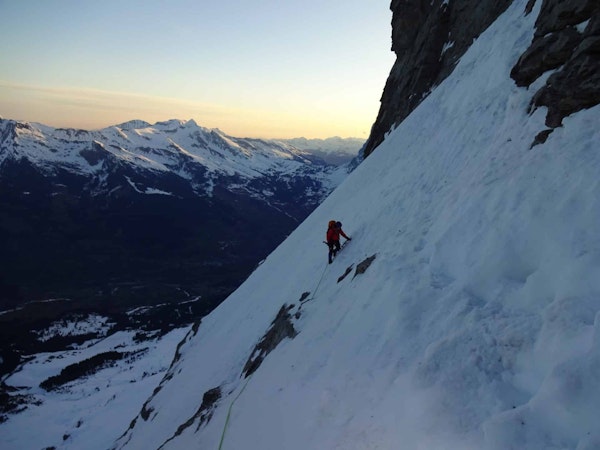
Any expedition to the summit of Eiger begins from the village of Grindelwald, Switzerland. From here, you will take the Jungfraubahn (R line) to either the Eigerwand (North Wall), Eismeer (Mittellegi Ridge) or Jungfraujoch (Western Flank), depending on which way you are climbing Eiger.
Getting to Grindewald generally involves a flight into the Geneva International Airport (GVA), which offers direct flights from most major airports around the world.
Once in Geneva, you can rent a car and make the incredibly scenic 2.5 hour drive via the A9, A1 and A6.
It is also possible to go by train or bus, but both will involve making transfers. The fastest you should expect to make the trip from GVA to Grindelwald is just under four hours.
Duration of the Ascent
From bottom to top and back, climbing Eiger takes about two days, but some guides take three days, giving you an extra day to come back down. Here is a list of a few of our most popular two and three-day options (listed in no particular order):
1| Eiger 2-day guided climbing traverse
2| Climbing Eiger North Face with a guide
3| Climbing Eiger North Face via Heckmair route
4| Eiger North Face 2-day guided climb
5| 3-day ascent of the Eiger via the Mittellegi Ridge
Many guides also offer four to six-day trips that combine the ascent with one or more other peaks. The most popular of which are neighboring Mönch and Jungfrau. Here is a list of a few of our most popular options for this itinerary (again, in no particular order).
1| Climbing Mönch and Mount Eiger via the Mittellegi ridge
2| 4-day Eiger, Mönch and Jungfrau Ascent in the Alps
3| Jungfrau, Eiger and Mönch 4-day climbing trip
4| Eiger, Mönch and Jungfrau 4-day ascent

Mountaineering courses (for people with previous mountaineering experience) that culminate with climbing Eiger are also offered, usually over five days or more. Here are a list of the most popular courses (once again, in no particular order):
1| Eiger Peak 5-day climbing course
2| 6-day Eiger ascent by the Mittellegi ridge
3| Mt Eiger, 7-day private guided climb and preparation
Climbing Routes
There are two popular climbing routes that get you to the summit of Eiger as well as two other routes. Most guides will take you up one of the first two routes listed here.
Mittellegi Ridge
The Mittellegi Ridge is the most popular option and best for intermediate climbers. It is usually used for the ascent followed by a descent down the South Ridge.
Climbing Eiger via this route generally begins with an immediate ascent after getting off the train from the Eismeer station. Three to four hours of technical climbing gets you to the Mittellegi Hut. It is ideal to get to there in the early afternoon in order to get ample time to rest before summit day.
From the hut, you will then make the four hour ascent to the summit via the Mittellegi Ridge. This requires four hours of intensive and technical climbing on a narrow and exposed ridge line. You will need to use a combination of pitched-out climbing and scrambling in order to reach the final snow slopes and then the true summit.
Headed back down the South Ridge, you will need to do a series of rappels and lowers as well as down climbing until you are back down in the Mönch saddle and from there can head back down to the Monchjoch Hut and then on to the nearby train station.
The North Wall

The North Wall is the most challenging route up Eiger and is widely considered to be an extreme and classic mountaineering challenge.
Best climbed in either the autumn or springtime because of the need for a bit of snow and ice, the North Wall is not to be taken lightly. A lack of frozen surface occasionally leads to rock falls on this side of the mountain, which can be deadly.
Stretching more than 1.800 meters up toward the heavens, any ascent of the North Wall begins with an arrival by train to the Eigerwand railway station. From here, you will hike out to the North Wall through a tunnel.
Upon emerging from the tunnel, the ascent begins. Using a combination of rock, ice and crack climbing, you make your way up for the remainder of the morning and well into the afternoon. The goal is to reach the two-thirds mark by mid-afternoon and spend the rest of the day resting.
The following day is summit day and after waking up early, you head out and up the rest of the day with more ice, rock and crack climbing.
After reaching the summit, you then head back down via the south route, on to the train station and back to civilization.
It is hard to overstate the difficulty of this route. Only advanced mountaineers should attempt it with a guide.
The South Ridge
The South Ridge route is generally used as alternative to the Mittellegi if there are less than optimal weather conditions. It is also the most frequent route used to descend from Eiger.
Starting from the Jungfraujoch, which is reached by the R-line train, you will hike for three to four hours over glacier until you reach the Monchjoch Hut.
From here, you wake up early the following morning and begin the ascent to the summit. This takes about five to six hours and requires some technical climbing over rock and ice.
Leaving the hut, you will head left across the glacier moving northward. You hike until you reach the Eigerjoch at about 3.680 meters then follow the south ridge up to the summit. You generally descend the way you came.
The Western Flank
The Western Flank is an archaic option that few guides choose to ascend from and many advise against it. Les Swindin of the British Alpine Club once described the route as, “like a tiled roof covered in debris”.
It was the historic descent route for many mountaineers who chose to climb the North Wall. It has since been replaced by the South Ridge due to its loose rock and shale, which lead to occasional rock slides.
Physical Requirements and Technical Difficulties

Regardless of the route up which you choose to ascend it, Eiger is a highly technical Alpine climb that involves rock, snow and ice climbing.
During the ascent, you will need previous experience with 5.7 grade rock climbing and be comfortable climbing on steep, but firm, snow and ice. Previous ice climbing and glacier hiking experience is useful, but not mandatory.
Previous Alpine climbing is also necessary. Many guides recommend climbing the Matterhorn in preparation for summiting Eiger.
It is recommended that intermediate level climbers head up to the summit via the Mittellegi Ridge. Summiting via the North Wall is best left for advanced climbers.
Along with the technical difficulties of summiting Eiger, it is also highly recommended that you are in excellent physical condition.
Prior to your mountaineering expedition, you should spend four to six months on physical preparation. This includes:
1| Climbing conditioning comprised of exercises such as hiking with heavy packs uphill and stair climbing.
2| Strength training, especially lower body and core exercises.
3| Cardiovascular training, including both aerobic and anaerobic workouts.
4| Flexibility training: since you will be flexing many muscles that you probably don’t use every day, it is important they are all limber and prepared for the climb. A muscle strain on the way up will prevent you from summiting.
For a complete guide to the exact fitness regimens you should follow prior to your ascent check out the “physical preparation” section of our guide to climbing Mont Blanc.
Weather Conditions

From June until September is the best time to attempt to climb Eiger (except by way of the North Wall). During the summer months, it is warmest at the summit of the mountain and is also when the peak gets the least rainfall, with an average of about eight rainy days per month.
At the summit, expect daily average temperatures of about -7ºC to -5ºC. However, with windchill it may feel much colder. At the base of the mountains, average temperatures are about 10ºC to 12ºC, so be sure to dress accordingly.
Some guides offer winter mountaineering expeditions to the summit of Eiger, mostly via the North Wall. Temperatures are much lower this time of year, dropping to -15ºC and -20ºC at the summit and snow is quite common. The peak receives an average of 12 days of snow each month.
Winter mountaineering trips should only be undertaken by advanced mountaineers.
Equipment

In order to successfully climb Eiger, it is important to come prepared with all the appropriate gear. Most guides will provide some of the group climbing equipment, but not all of them do. This is something you need to check with your guide prior to booking.
Regardless of what is or is not included, here is a list of all the necessary climbing equipment:
Belay device.
Carabiners, both standard and locking.
Climbing harness.
Crampons.
Helmet.
Ice axe.
Personal anchoring system.
Sleeping bag liner.
Trekking poles.
Along with this climbing equipment, it is important to pack other necessary clothing and miscellaneous items for your trip. Here is what guides recommend you bring:
Baselayer tops and bottoms that fit snugly, but do not constrict. No cotton.
Camera and extra batteries.
Cash in Swiss francs (CHF) and credit card.
Climbing pack, at least 30 litres.
First aid kit
Fleece or windbreaker.
Gaiters, waterproof and comfortable.
Gloves, three pairs: liner, softshell and leather climbing pairs.
Hardshell pants and jacket, both of which should be waterproof and fit comfortably over the base layer and softshell layers.
Head lamp.
Hiking boots for the approach and mountaineering boots for the ascent.
Hiking socks, at least two pairs.
Insulated jacket, preferably lightweight.
Insurance
Shorts, for the approach.
Softshell pants and jacket, both of which should fit comfortably over the base layers or without the base layers. No cotton.
Sun cream, lip balm and sun glasses
Sun hat and knit cap, preferably synthetic or wool.
Toiletries.
Underwear, two to three pairs of wool or synthetic fibre (no cotton).
Water bottle, at least one-litre. Some guides also recommend a hydration system, such as MSR Hydrometry (a more durable version of Camelbak).
Estimated Price
Prices for mountaineering expeditions to the summit of Eiger vary considerably, depending on several factors. How long your trip is, what is included and how many people you are climbing with will all influence the price.
That being said, expect to pay at least €1.000 to €2.000 for a classic two or four day ascent. This price usually just includes the guide fee and, sometimes, group equipment. Make sure to budget more for transport costs, food and accommodation expenses and the cost of some rental equipment.

So what are you waiting for? Book now for an unforgettable mountaineering experience to the summit of the stunningly scenic Eiger!
